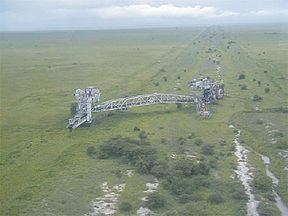Status Incomplete | ||
 | ||
The Jonglei Canal is a project that has been proposed, started but never completed to divert water through the vast Sudd wetlands of South Sudan so as to deliver more water downstream to Sudan and Egypt for use in agriculture.
Contents
Map of Jonglei Canal, South Sudan
Concept
Due to the Sudd swamp, the water from the southwestern tributaries of the Nile, the Bahr el Ghazal system, for all practical purposes does not reach the main river and is lost through evaporation and transpiration. Hydrogeologists in the 1930s proposed digging a canal east of the Sudd which would divert water from the Bahr al Jabal above the Sudd to a point farther down the White Nile, bypassing the swamps and carrying the White Nile's waters directly to the main channel of the river.
Planning and construction
Sir William Garstin, Undersecretary of State of Public Works of Egypt, created the first detailed proposal for digging a canal east of the Sudd in 1907. By bypassing the swamps, it was calculated that evaporation of the Nile's water would vastly decrease, allowing an increase in the area of cultivatable land in Egypt by two million acres.
The Jonglei canal scheme was first studied by the government of Egypt in 1946 and plans were developed in 1954-59. Construction work on the canal began in 1978 but the outbreak of political instability in Sudan has held up work for many years. By 1984 when the Sudan People's Liberation Army (SPLA) brought the works to a halt, 240 km of the canal of a total of 360 km had been excavated.
The rusting remains of the giant German-built excavation machine – nicknamed "Sarah" - are visible in satellite images near the south end of the canal. It was damaged by a missile. As peace was restored in 2000, speculation grew about a restart of the project. However on February 2, 2008, the Sudanese Government said the revival of the project was not a priority. However, in 2008, Sudan and Egypt agreed to restart the project and finish the canal after 24 years.
Potential impact
It is estimated that the Jonglei canal project would produce 3.5-4.8 x 109 m³ of water per year (equal to a mean annual discharge of 110–152 m³/s (3,883-5,368 ft³/s), an increase of around five to seven per cent of Egypt's current supply.
Little or no consideration had been given within Egypt to the ability of the Sudd swamplands to act as a sponge and regulator of floodwaters.
The canal's highly questionable benefits would be shared by Egypt and Sudan, with the expected damage falling on South Sudan. The complex and potentially catastrophic environmental and social issues involved, including the collapse of fisheries, drying of grazing lands, a drop of groundwater levels and a reduction of rainfall in the region, may limit the scope of the project in practical terms.
